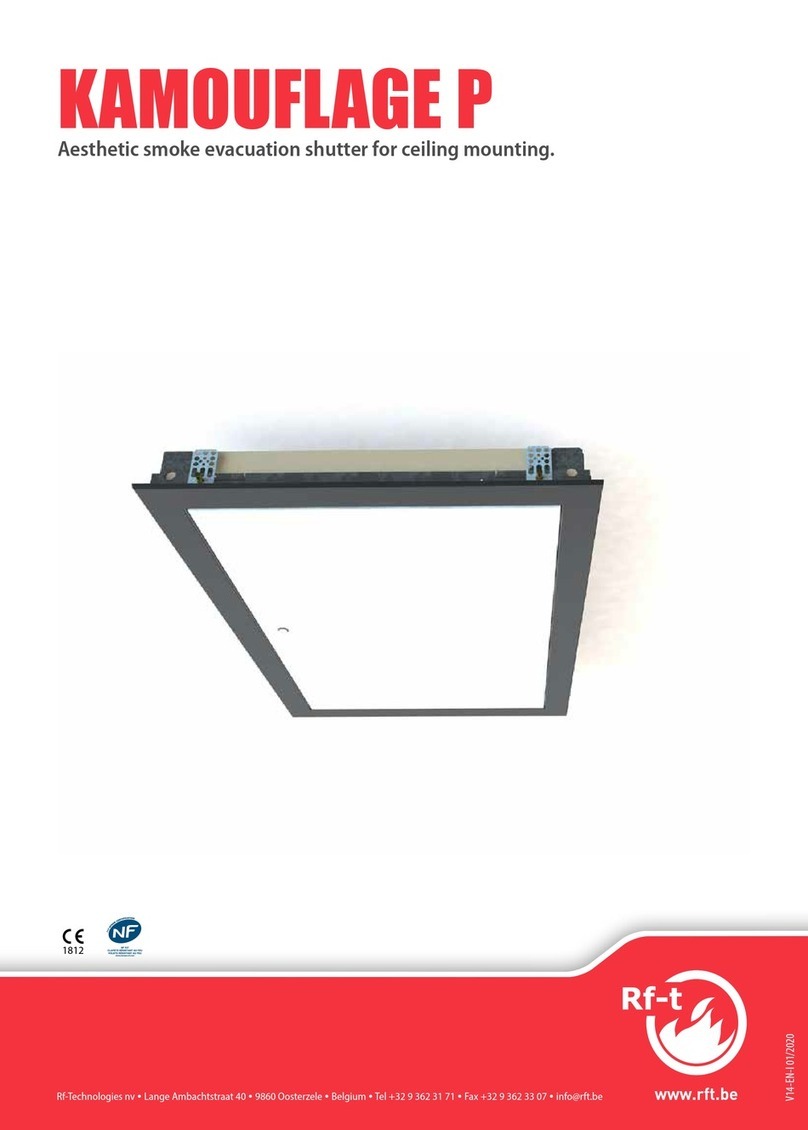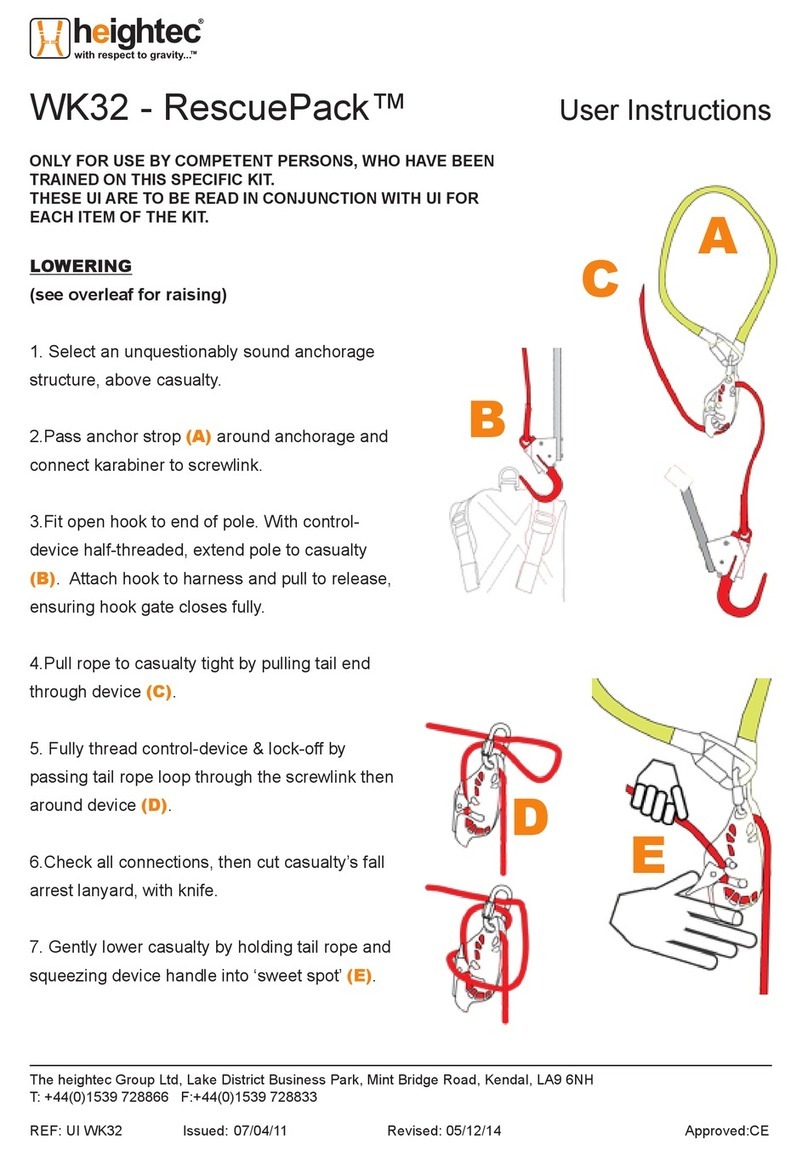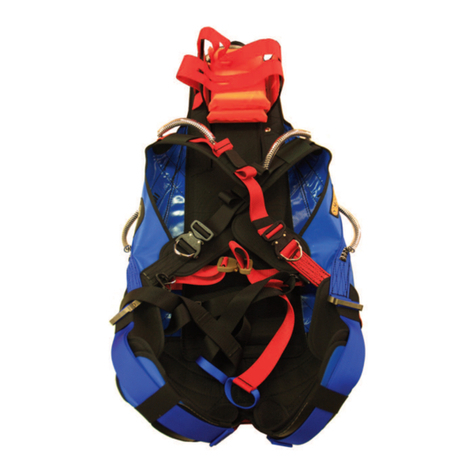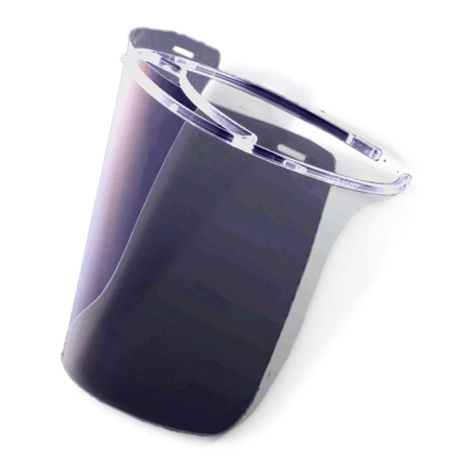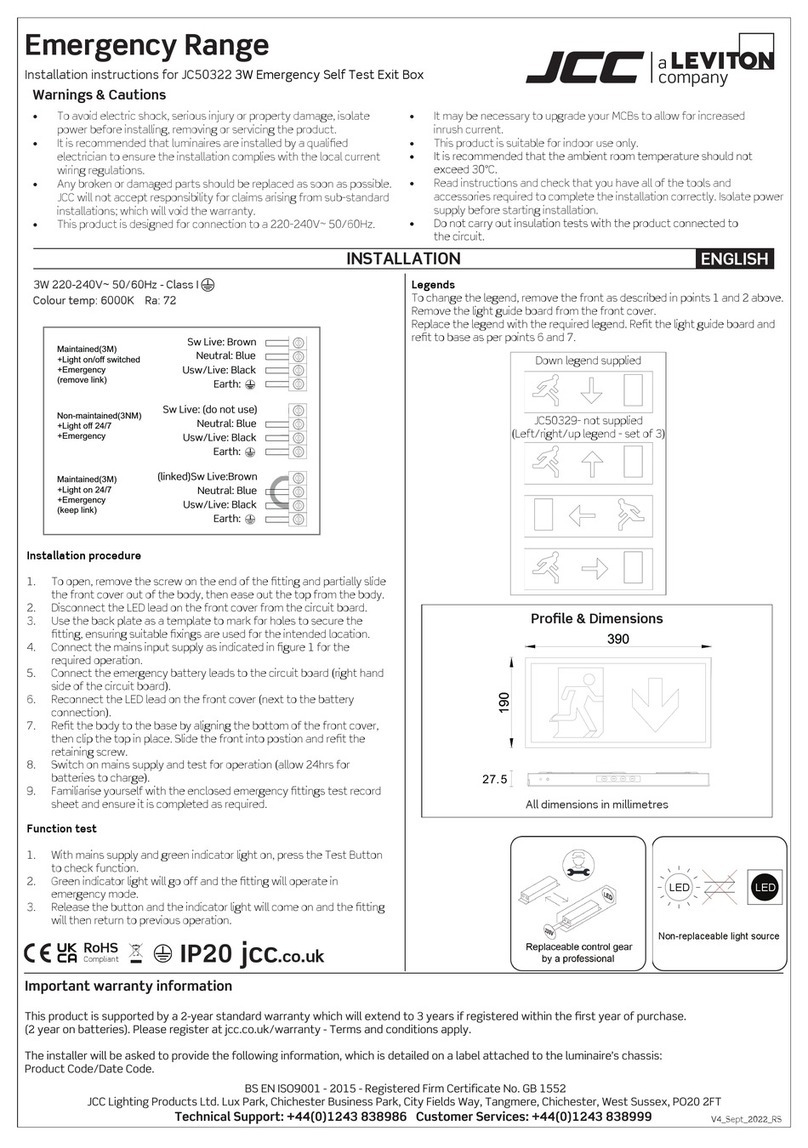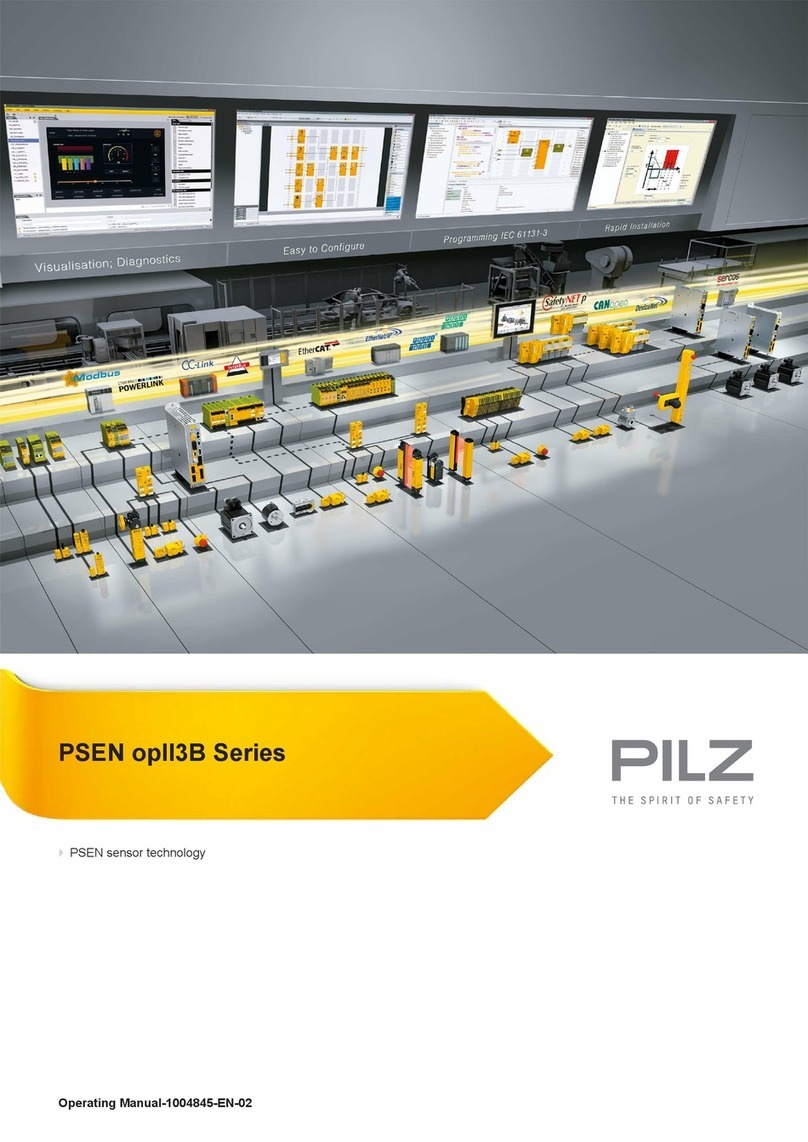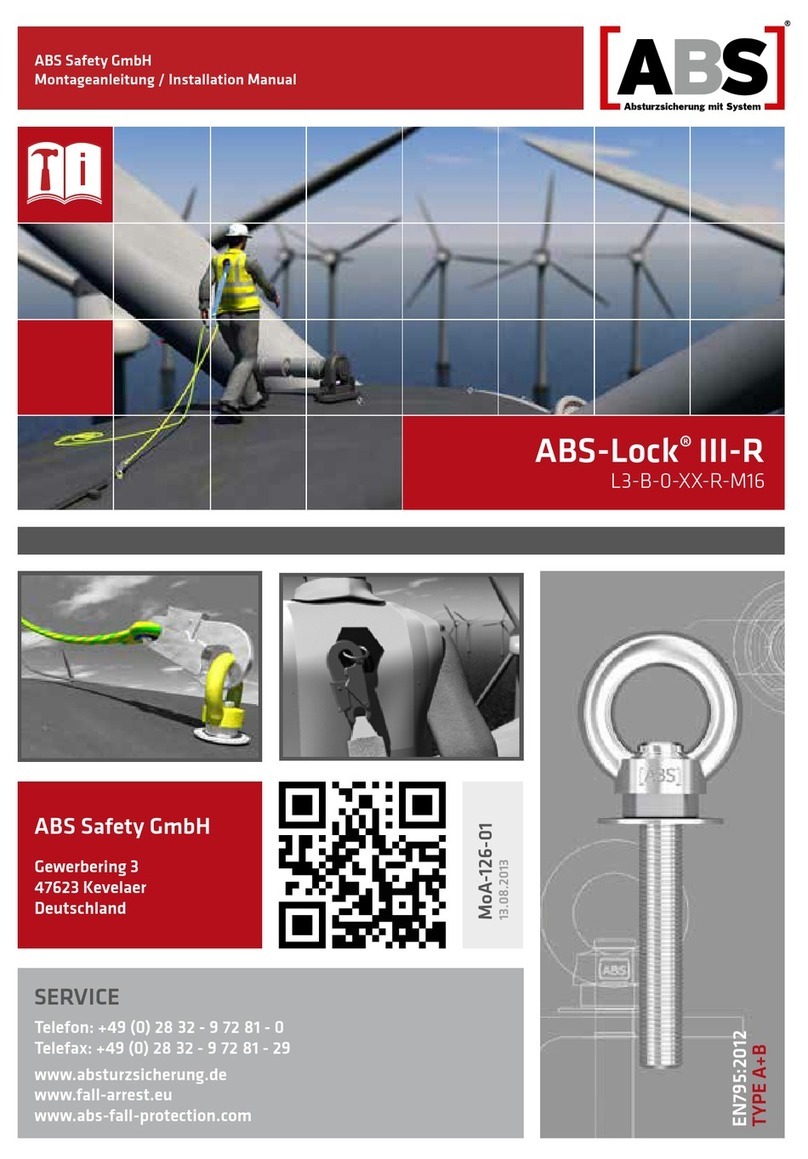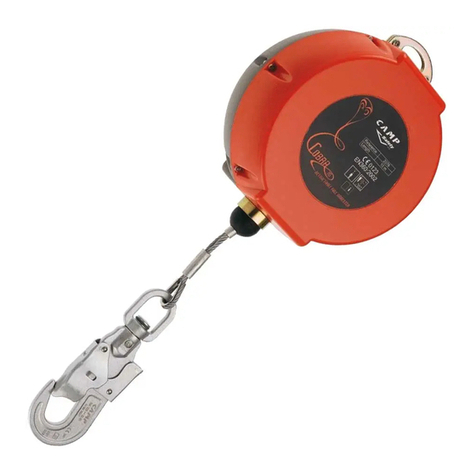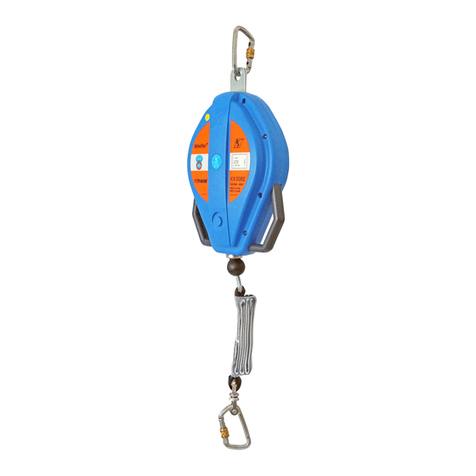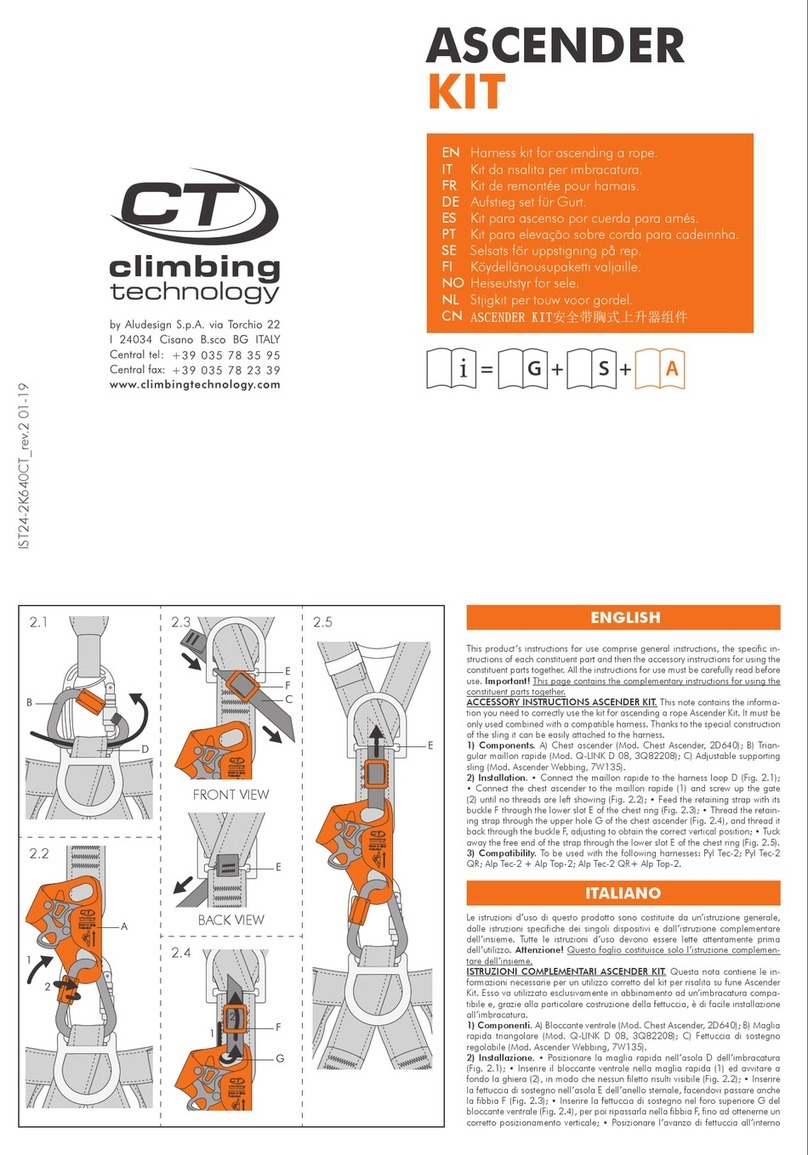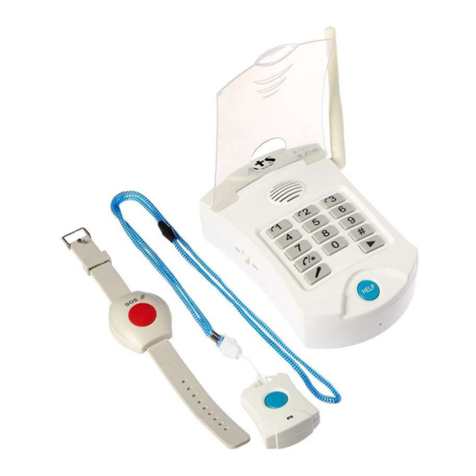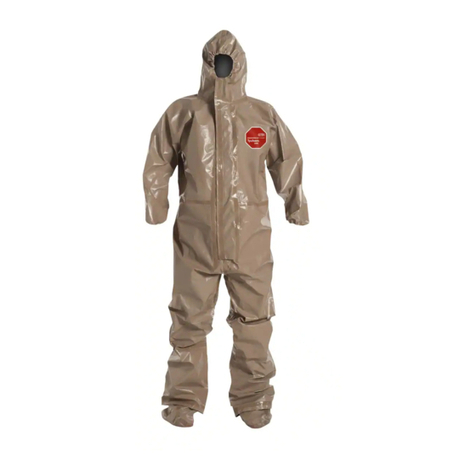tau BSD User manual

BSD
BORDO SENSIBILE
BORD SENSIBLE DE SECURITE
SAFETY EDGE
Cert.
EN12978
Manuale di Installazione
D-MNL0BSD
Rev. 14-01
Pag.1
a. Legenda e simboli Légende des symboles Key
Segnala le parti del manuale da leggere con attenzione Il signale les parties du manuel qui doivent être
lues soigneusement
It indicates the parts of the manual to be read
carefully;
Segnala parti riguardanti la sicurezza Il signale les parties qui concernent la sécurité; It indicates the parts related to safety;
Segnala le informazioni dirette all’ utente nale (utiliz-
zatore)
Il signale les informations adressées à l’usager
nal (utilisateur)
It indicates the information aimed to the nal user
(consumer)
MBS Misura del Bordo Sensibile che si desidera ottenere
(calotte comprese)
Mesure du Bord Sensible qu’on veut obtenir
(couvercle compris) Safety Edge size you wish to obtain (cap included)
b. Destinazione d’uso Destination d’usage Destination of use
Il bordo sensibile BSD viene utilizzato come dispositivo
di sicurezza su impianti di automazione per cancelli a
scorrimento orizzontale e ad anta, a protezione di rischi
di schiacciamento ed intrappolamento. La deformazione
della gomma provoca l’intervento del bordo sensibile lun-
go tutta la sua altezza.
La conformità alla normativa EN12978 del bordo sensi-
bile BSD è subordinata al Test di Controllo da parte della
centrale di comando.
Le bord sensible BSD est utilisé comme un disposi-
tif de sécurité dans des systèmes d’automatisation
pour portails coulissantes et à battente, contre les
risques de concassage et de piégeage. La défor-
mation du caoutchouc provoque l’intervention du
bord sensible sur toute sa hauteur.
La conformité à la norme EN12978 de le bord sen-
sible BSD est soumis à des tests de contrôle de
l’unité de commande.
The safety edge BSD is used as a safety device for
automation sistems for sliding and swinging gates,
as protection against risks of crushing and trapping.
The deformation of the rubber causes the interven-
tion of the safety edge along its entire height.
Compliance to EN12978 rules of the edge sensitive
BSD is subject to the Control Testing by the control
unit.
Utilizzi diversi da quanto sopra descritto del bordo sen-
sibile BSD o installazione non eseguita in conformità a
quanto descritto nel seguente manuale possono pregiu-
dicare il corretto funzionamento del dispositivo.
Utilisations du bord sensible BSD différentes de ce
qui a été ci-dessus décrit ou installations pas exé-
cutées en conformité avec ce qui est décrit dans ce
manuel peuvent compromettre le correct fonction-
nement du dispositif.
Uses of BSD safety edge which are different from
what above mentioned or installations which are not
realized according to what described in this manual
can compromise the right working of the device.
c. Destinazione d’uso Destination d’usage Destination of use
L’ installazione del bordo sensibile BSD dovrà essere
eseguita da installatori qualicati.
L’installation du bord sensible BSD doit être exécu-
tée par installateurs qualiés.
The installation of BSD safety edge must be realized
by qualied tters.
Il bordo sensibile non necessita di particolari operazioni
di riarmo/riavvio da eseguire in seguito ad un’allarme del
dispositivo, inquanto il ripristino avviene automaticamen-
te. Per i guasti in cui permane l’allarme del dispositivo,
fare riferimento alla tabella g.2 “risoluzione dei problemi”.
Le bord sensible ne nécessite pas d’opérations
spéciales de réinitialisation/remise à exécuter en
réponse à un alarme dans le dispositif, parce que
la récupération s’effectue automatiquement. Pour
les défauts qui maintient le dispositif en alarme,
reportez-vous au tableau g.2 «dépannage».
The safety edge requires no special operations reset/
restart to execute in response to an alarm device, as
recovery takes place automatically. For faults which
keeps the device alarm, please refer to the table g.2
“troubleshooting”.
L’installatore deve far conoscere all’utente nale i dispo-
sitivi di sicurezza e le loro caratteristiche ed istruirlo in
modo tale che le aree che danno accesso ai dispositivi
del sistema vengano mantenute libere da ostacoli.
L’installateur doit faire connaître à l’utilisateur nal
les dispositifs de sécurité et leurs caractéristiques
et lui informer que les zones qui donnent accès au
système soyent maintenus libres de tout obstacle.
The tter must introduce the end user to the safety
devices and their characteristics and inform him so
that the areas that give access to the system devices
must be kept free of obstacles.
ll bordo sensibile BSD va posizionato in sede verticale
avendo cura di montare la scheda con i microswitches
nella parte superiore.
Le bord BSD doit être placé à la verticale, en pre-
nant soin de monter la carte avec les micros dans
la partie supérieure.
BSD Sensitive edge must be positioned in the ver-
tical, taking care to mount the card with the micro-
switches in the upper part.
Il bordo sensibile BSD è formato da un’ estruso in gom-
ma con dopocorsa elastico di ammortamento urto, e da
un prolo in alluminio che, ssato alla colonna o al can-
cello, funge da supporto all’ estruso.
Il funzionamento del dispositivo è garantito da 2 mi-
croswitches. Entrambi lavorano su deformazione della
costa comprensiva delle calotte morbide poste alle estre-
mità e come sicurezza nel caso in cui il cavo di acciaio
dovesse perdere tensione.
Le bord BSD est formé par un caoutchouc extrudé
avec après-course d’amortissement de choc élas-
tique et par un prolé en aluminium qui est xé
à la colonne ou à la grille et qui agit comme un
support. Le fonctionnement du dispositif est garanti
par 2 micro-interrupteurs. Les deux travaillent sur
la déformation de la barre y compris les capuchons
souples aux extrémités et comme sécurité dans le
cas où le câble d’acier perd sa tension.
The safety edge BSD is composed by an extruded
rubber with elastic after-run of amortization and an
aluminum prole that is xed to the column or to the
gate and it acts as a support. The operation of the
device is guaranteed by 2 microswitches. Both work
on deformation of the edge including soft caps at the
ends if the steel cable lose tension.
c. Caratteristiche tecniche Caractéristiques techniques Technical features
Materiali
Estruso morbido in TPE
Matériels
Extrudé souple en TPE
Materials
TPE soft extruded
Estruso rigido in alluminio Extrudé rigide en aluminium Aluminium hard extruded
Parti rigide in nylon Composants rigides en nylon Nylon parts
18mm Precorsa Pré-course Pre-run
24mm Oltre corsa Aprés-course After-run
12m/min Velocità max di rilevamento Vitesse max de relévement Max. bearing speed
>0.15 s
>2 s
Tempo di risposta con avanzamento 12 m/min
Tempo di risposta con avanzamento a 0.6 m/min
Temps de réponse avec avancement à 12 m/min
Temps de réponse avec avancement à 0,6 m/min
Response time with feed 12 m / min
Response time with feed 0.6 m / min
< 2 s Tempo di recupero deformazione Temps de recouvrement Distorsion recovery time
J1 NC
J1 R
Uscita contatto NC
Uscita contatto resistivo
Sortie contact NC
Sortie contact résistif
NC Contact output
Resistive Contact output
8,2 KΩ Valore resistenza Valeur résistance Resistance value
-10°C / +60°C
Temperatura d’esercizio Température d’exercise Working temperature
93% Umidità relativa a 40° C Humidité relative à 40° C Relative humidity at 40° C
IP54 Grado di protezione Degré de protection Protection degree
2/3
EN954-1 Categoria di appartenenza con elettronica di controllo Catégorie d’appartenance avec électronique de
contrôle Category of belonging with electronic control

e. Montaggio Bordo Sensibile Montage du Bord Sensible Safety Edge installation
L’installazione del Bordo Sensibile BSD dovrà essere
eseguito da installatori qualicati
ATTENZIONE: Apportare modiche al sistema e/o alla
sua congurazione non autorizzate dal fabbricante pos-
sono causare situazioni pericolose.
L’installation du Bord Sensible BSD doit être exé-
cutée par installateurs qualiée.
ATTENTION: Apporter des modications au sys-
tème et/ou à sa conguration pas autorisés par le
fabricant peut causer des situations dangereuses.
The installation of BSD Safety Edge must be realized
by qualied tters.
WARNING: Make changes to the system and/ or its
conguration not authorized by the manufacturer
may cause dangerous situations.
e.1 Fissaggio della costa Fixage de la barre Fixing of the safety edge
e.1.1 Per modicare l’altezza del bordo sensibile vedere le
istruzioni riportate al punto “ f “.
Pour changer la hauteur du bord sensible suivre
les instructions données dans « f ».
To change the height of the edge sensitive follow the
instructions given in “ f “.
e.1.2
Fissare le CLIP (DIS.1 part.1) alla colonna o al cancello
facendo riferimento alle quote riportare nella TAB 1 (H1.1
/ H 1.2 / H 1.3)
Fixer le CLIP (DIS.1 part.1) à la colonne ou à la
grille en se référant à la TAB 1 (H1.1 / H 1,2 / H 1,3)
Fix the CLIP (DIS.1 part.1) to the column or to the
gate by reference to the shares back in TAB 1 (H1.1
/ H 1.2 / H 1.3)
e.1.3
Inserire la costa nelle CLIP e ssarla alla colonna o al
cancello con i fori predisposti (DIS.1 part.2), vedi TAB
1 (H 2.1 / H 2.2)
Entrez la barre dans les CLIPS et xez-la par les
trous à la colonne ou à la grille (DIS.1 part.2), voir
TAB 1 (H 2.1 / H 2.2)
Fit the edge to the CLIP in the column or in the gate
and secure with holes (DIS.1 part.2), see TAB 1 (H
2.1 / H 2.2)
e.2 Collegamento Connexion Connection
- Montato il Bordo Sensibile alla colonna o al cancello
eseguire i collegamenti della costa secondo lo schema
allegato (DIS.2 part.1)
- Il jumper J1 seleziona il tipo di contatto che si vuole
utilizzare sui morsetti di collegamento:
J1 NC = Contatto NC (DIS.2 part.2)
J1 R = Contatto resistivo 8,2 KΩ (DIS.2 part.3)
- Une fois assemblé le bord à la colonne ou à la
grille, effectuer les liens du bord selon le schéma
ci-joint (DIS.2 part.1).
- Le jumper J1 sélectionne le type de contact que
vous souhaitez utiliser avec les bornes de raccor-
dement:
J1 NC= Contact NC (DIS.2 part.2)
J1 R = Contact résistif 8.2KΩ (DIS.2 part.3)
- Once you have x the safety edge to the coloumn
or to the gate, make connections to the edge, ac-
cording to the attached diagram (DIS.2 part.1)
- The jumper J1 selects the type of contact that you
want to use the connection terminals:
J1 NC= NC contact (DIS.2 part.2)
J1 R = Contact resistance 8,2KΩ (DIS.2 part.3)
e.3 Tensionatura cavo e taratura Tension du câble et tarage Cable tension and calibration
La costa viene già fornita con una pretensionatura del
cavo. E’ tuttavia possibile eseguire una ulteriore regola-
zione della costa agendo sulla VITE (DIS.3 part.1) posta
sul braccio del supporto superiore della costa.
Ruotando in senso orario si aumenterà la sensibilità della
costa (+)
Ruotando in senso antiorario si diminuirà la sensibilità
della costa (-).
Il funzionamento ottimale del dispositivo si ottiene con
l’intervento elettrico dello stesso con una deformazione
al centro del bordo sensibile pari a circa 20 mm (DIS.4)
La barre est déjà fournie avec le câble prétensioné.
Cependant il est possible effectuer un ajustement
de la barre en tournant la VIS (DIS.3 part.1) placée
sur le bras de la partie supérieure de la barre.
En tournant vers la droite la sensibilité de la barre
va augmenter (+)
Tournant vers la gauche la sensibilité de la barre
va diminuer (-)
Le fonctionnement optimal du dispositif est réalisé
à l’intervention électrique de la même avec une
déformation au centre de la barre égale à environ
20 mm (DIS.4)
The safety edge is already provided with the preten-
sioned cable. However, you can make further adjust-
ment by turning the SCREW (DIS.3 part .1) on the
arm of the upper support of the edge.
Turning clockwise will increase the sensitivity the
coast (+)
Turning counterclockwise will decrease the sensitiv-
ity the coast (-)
Optimum operation of the device is achieved with the
electrical intervention with a deformation at the cen-
ter of the safety edge equal to about 20 mm (DIS.4)
e.4 Inserimento delle calotte Encastrement des capuchons Positioning of the cap
- Per inserire la calotta morbida, posizionarla frontal-
mente alla piastra di supporto, avendo cura di fare
scorrere le alette terminali nelle proprie sedi di conteni-
mento (DIS.5 part.1) e i due ganci laterali di bloccaggio
all’interno delle feritoie predisposte (DIS.5 part.2). Ap-
plicare una leggera pressione afnchè vi sia uno scatto
ad indicare il corretto collocamento della stessa.
- Fissare la calotta con la vite in dotazione (DIS.5 part.3).
- Per rimuovere la calotta agire in maniera inversa: to-
gliere la vite di testa (DIS.5 part.3), sganciare la calotta
inserendo un utensile all’interno delle feritorie spingen-
do i ganci verso l’interno.
- Pour encastrer le capuchon souple, le placer en
face de la plaque de support, en prenant soin de
faire glisser les extrémités libres dans leur sièges
(DIS.5 part.1) et les deux crochets latérals de
blocage à l’intérieur des fentes disposées (DIS.5
part.2). Appliquez une légère pression pour qu’il
y ait un déclic pour indiquer le positionnement
correct du capuchon.
- Fixez le capuchon avec la vis fournie (DIS.5
part.3).
- Pour retirer le capuchon agir en sens inverse:
enlever la vis (DIS.5 part.3), relâchez le capu-
chon en insérant un outil à l’intérieur des fentes
en poussant les crochets vers l’intérieur.
- To insert the soft cap, place it in front of the support
plate, taking care to slide the aps in their seats
(DIS.5 part.1) and the two lateral locking hooks
inside of slits arranged (DIS.5 part.2). Apply light
pressure so that there is a click to indicate the cor-
rect placement of the same.
- Secure the cover with the screw provided (DIS.5
part.3).
- To remove the cover please act in reverse: remove
the screw (DIS.5 part.3), release the cap by insert-
ing a tool inside the slits pushing the hooks inward.
Nota Note Note
Allo scopo di migliorare lo scarico di eventuali sedimenti
che potrebbero formarsi all’interno della calotta inferiore
è consigliabile praticare un foro come indicato nel DIS.5
(part.4).
An d’améliorer l’évacuation de tout sédiment pou-
vant se former à l’intérieur du capuchon inférieur il
est conseillé de percer un trou comme il est indiqué
ci-après en DIS.5 (part.4).
In order to improve the discharge of any sediment
that may nd inside the bottom cap, it is advisable to
drill a hole as shown in DIS.5 ( part.4).
TAB. 1 Quote ssaggio Bordo Sensibile Niveaux de xation du Bord Sensible Safety Edge fastening gures
Altezza foro ss. CLIP (mm)
Hauteur trou xation CLIP(mm)
Height of the xing hole for CLIP (mm)
Altezza foro ss. SUPPORTI (mm)
Hauteur trou xation SUPPORTS (mm)
Height of the xing hole for SUPPORTS (mm)
MBS
Misura Bordo Sensibile
Dimension du Bord Sensible
Safety edge size
H 1.1 H 1.2 H 1.3 H 2.1 H 2.2
1000 mm 500
22
978
1.500 mm
200
1300 1478
1.700 mm 1500 1678
2.000 mm 1000 1800 1978
2.500 mm 1250 2300 2478
3.000 mm 1500 2800 2978
4.000 mm 2000 3800 3978
Pag.2

DIS. 1 DIS. 3
DIS. 4
DIS. 5
DIS. 2
PART.2
PART.1
PART.1
PART.1
PART.2
+
-
PART.1
20 mm
PART.1
PART.2
PART.3
PART.4 Ø5mm
PART.1
INGRESSO CAVI
ENTREE CABLES
CABLE ENTRY
PART.2
J1=NC
PART.3
J1=8.2KΩ
Pag.3

f. Modicare altezza bordo sensibile
Changer la hauteur du bord sensible
Change the safety edge size
f.1 Smontaggio del bordo sensibile Démontage du Bord Sensible Safety Edge disassembly
- Inserire il fermo di rotazione fornito in dotazione e
bloccare il movimento della camma di attivazione mi-
croswitch (DIS. 6 part. 1)
- Allentare il grano del giunto (DIS. 6 part. 2) che serra il
cavo proveniente dalla parte inferiore della costa.
- ATTENZIONE: Non allentare il grano del giunto che
serra il cavo proveniente dalla camma (DIS.6 part.3)
- Insérez l’arrêt de rotation fourni et bloquez le
mouvement de la came (DIS.6 part. 1)
- Dévissez la goupille de verrouillage (DIS. 6 part.
2) qui bloque le câble provenant de la partie infé-
rieure de la barre.
- ATTENTION: Ne desserrez pas la goupille
de verrouillage qui bloque le câble de la came
(DIS.6
- Insert the supplied stop position and block the
movement of the cam (DIS. 6 part. 1)
- Unscrew the locking pin (DIS. 6 part. 2) that locks
the cable coming out from the lower part of the
edge.
- CAUTION: Do not loosen the locking pin that locks
the cable from the cam (DIS.6 part.3)
Slare il cavo dal giunto no al supporto inferiore della
costa ( DIS. 7 part.1).
Débranchez le câble du raccord jusqu’au support
inférieur de la barre (DIS. 7 part.1).
Remove the cable from the joint to the lower support
of the edge (DIS. 7 part.1).
Togliere il supporto superiore dal prolo in alluminio (DIS.
7 part.2)
Enlever le support supérieur du prol d’aluminium
(DIS. 7 part.2)
Remove the upper support from the aluminum prole
( DIS. 7 part.2)
Slare completamente l’estruso in gomma dal prolo di
alluminio ( DIS. 7 part.3)
Retirer completement le caoutchouc de l’alumi-
nium (DIS. 7 part.3)
Withdraw the rubber from aluminum bar (DIS. 7
part.3)
f.2 Modica altezza Modication de la longueur Size changing
Tagliare l’estruso in alluminio ed il prolo in gomma della
stessa misura per ottenere l’altezza desiderata.
Il bordo in gomma deve risultare 40mm più lungo del
prolo in alluminio.
ES. - Per ottenere una costa da MBS = 1800 mm
Estruso in gomma = MBS mm - 245 mm = 1555 mm
Prolo in alluminio = MBS mm - 285 mm = 1515 mm
Couper l’aluminium et le caoutchouc de la même
taille pour obtenir la hauteur souhaitée.
Le bord en caoutchouc doit être de 40 mm plus
long que le prolé en aluminium.
ES. - Pour obtenir un bord à MBS = 1800 mm
Extrudés caoutchouc = MBS mm - 245 mm = 1555mm
Prolé aluminium = MBS mm - 285 mm = 1515 mm
Cut the extruded aluminum and the rubber in the
same size to get the desired height.
The rubber edge should be 40mm longer than the
aluminum prole.
ES. - To get a edge of MBS = 1800 mm
Extruded Rubber = MBS mm - 245 mm = 1555 mm
Aluminum prole = MBS mm - 285 mm = 1515 mm
DIS. 6 DIS. 7
PART.1
PART.2
PART.3
PART.2
PART.3
PART.1
Pag.4

Pag.5
f.3 Montaggio del bordo sensibile Montage du Bord Sensible Safety Edge installation
Improlare l’estruso in gomma nel prolo di alluminio
(DIS. 8 part.1).
Ad operazione conclusa il bordo in gomma dovrebbe
debordare di 20mm rispetto al prolo in alluminio (DIS.
9 part.1)
Faites glisser le caoutchouc dans l’aluminium (DIS.
8 part.1).
Lorsque vous avez terminé le bord en caoutchouc
devrait déborder sur 20mm par rapport au prol
d’aluminium (DIS.9 part.1)
Slide the rubber in the aluminum prole (DIS. 8
part.1).
When you have nished the rubber edge should spill
over 20mm compared to the aluminum prole (DIS.
9 part.1)
Riassemblare il supporto superiore nel prolo in allumi-
nio (DIS. 9 part .2)
Remonter le support supérieur sur le prolé d’alu-
minium (DIS.9 part.2)
Reassemble the upper support in the aluminum pro-
le (DIS.9 part .2)
- Riassemblare il cavo facendolo scorrere attraverso il
cavidotto presente nel bordo in gomma (DIS. 9 part.3)
- Inserire il cavo nel giunto (DIS. 9 part.4) facendolo
uscire dal foro obliquo di passaggio.
- Remonter le câble en acier à travers la conduit
logé dans le bord en caoutchouc (DIS. 9 part.3)
- Branchez le câble dans le raccord (DIS. 9 part.4)
en le sortant par le trou oblique.
- Reassemble the steel cable through the cable con-
duit housed in the rubber edge (DIS.9 part.3)
- Plug the cable into the joint (DIS. 9 part.4) by taking
it out of the oblique hole.
- Mantenendo in tensione il cavo in acciaio, serrare il
grano di blocco presente nel giunto (DIS.10 part.2)
- Rimuovere il fermo di rotazione (DIS. 10 part.1)
- Procedere al «Collegamento» della costa come al p.to
“e.2” Pag.2
- Procedere alla «Tensionatura cavo e taratura» come al
p.to “e.3” Pag.2
- Procedere all’«Inserimento delle calotte» come al p.to
“e.4” Pag.2
- En maintenant la tension sur le câble en acier,
serrez la goupille de verrouillage dans raccord
(DIS.10 part.2)
- Retirer l’arrêt de rotation (DIS. 10 part.1)
- Procéder à la «Connexion» de la barre selon
“e.2” Pag.2
- Procéder à la «Tension du cable et tarage» selon
“e.3” Pag.2
- Procéder à l’ «Encastrement des capuchons»
selon “e.4» Pag.2
- Keeping tension on the steel cable, clamp the lo-
cking pin in this joint (DIS.10 part.2)
- Remove the rotation latch (DIS. 10 part.1)
- Proceed to the Connection « » of the edge in accor-
ding to “e.2” Pag.2
- Proceed to «Cable tension and calibration» in ac-
cording to”e.3” Pag.2
- Proceed to «Positioning of the cap» in according to
“e.4” Pag.2
DIS. 10DIS. 8
DIS. 9
PART.1
PART.2
PART.1
PART.1
20mm
PART.4
PART.2
PART.3

Pag.6
g. Informazioni per l’utente nale
Informations pour l’usager nal
Information for the end user
g.1 Manutenzioni Maintenance Maintenance
g.1.1
Il bordo sensibile BSD non necessita di manutenzioni
particolari, è consigliabile tuttavia effettuare un controllo
periodico (ogni 6 mesi).
Di ogni verica deve essere mantenuta la registrazione
(vedi registro di manutenzione nel manuale utente).
E’ buona norma asportare eventuali sostanze estranee
effettuando una pulizia con aspiratori.
Le bord sensible BSD ne nécessite de aucune
maintenance particulière, mais un contrôle pério-
dique (tous les 6 mois) est recommandé.
Chaque contrôle doit être enregistré (voir le cahier
de maintenance dans le manuel de l’usager).
Il est bon d’emporter substances étrangères en
nettoyant avec aspirateurs.
BSD safety edge does not need special mainte-
nance, yet a periodic check (every 6 months) is
recommended.
Each check must be registered (see maintenance
register in the user manual).
It is recommended to remove any extraneous sub-
stances cleaning with exhausters.
g.1.2
Apportare modiche al sistema e/o alla sua congura-
zione non concordate con il fabbricante posso causare
situazioni pericolose.
Qualsiasi intervento di manutenzione o taratura del di-
spositivo dovrà essere effettuata da installatori qualicati.
Vericare la presenza e la buona leggibilità della marca-
tura d’identicazione del prodotto.
Toutes modications du dispositif peuvent provo-
quer des situations dangereuses.
Les interventions de maintenance et tarage du dis-
positif doivent être exécutées par des installateurs
qualiés.
Vériez la présence et la lisibilité du marquage
d’identication du produit.
Any device modication can cause dangerous situ-
ations.
Any intervention of maintenance and calibration of
the device must be realized by qualied tters.
Check for presence and legibility of the marking of
product identication.
g.2 Risoluzione dei problemi Dépannage Troubleshooting
g.2.1
Problema riscontrato:
Bordo Sensibile non interviene
Problème rencontré:
le bord sensible n’intervient pas
Problem found:
The safety edge does not intervene
Possibili cause:
Guasto collegamenti
Causes possibles:
Liens défectueux
Possible causes:
faulty links
Interventi da effettuare:
Porre l’automazione in «funzionamento manuale» e ri-
volgersi all’assistenza
Opérations à réaliser:
Placez l’automation en mode “manuel” et appelez
le support technique
Operation to be performed:
Place the automation in “manual mode” and call for
service
g.2.2
Problema riscontrato:
Bordo Sensibile interviene in ritardo
Problème rencontré:
le bord sensible intervient en rétard
Problem found:
The safety edge intervenes late
Possibili cause:
Tensionamento cavo acciaio insufciente
Causes possibles:
Tension du câble en acier insufsant
Possible causes:
Low steel cable tension
Interventi da effettuare:
Rivolgersi all’assistenza
Opérations à réaliser:
Appelez le support technique
Operation to be performed:
Call for service
g.2.3
Problema riscontrato:
Automatismo bloccato in posizione «aperta»
Problème rencontré:
Automatisme bloqué en position “ouvert”
Problem found:
Automatic locked in “open” position
Possibili cause:
Bordo sensibile in allarme. Guasto sul collegamento o
perdita taratura
Causes possibles:
Bord de sécurité en état d’alarme. Problèmes de
connexions
Possible causes:
Safety edge in alarm. Failure connecting
Interventi da effettuare:
Vericare che non vi siano oggetti che pongano il bordo
in «allarme» e rivolgersi all’assistenza
Opérations à réaliser:
Vériez s’il y a des objets qui mettent le bord en
“alarm” et contactez le support technique
Operation to be performed:
Verify if there are objects that place the edge in
“alarm” Call for service
h. Registro delle manutenzioni
Cahier de maintenance
Maintenance register
TIMBRO DEL RIVENDITORE / TAMPON DU VENDEUR / DEALER STAMP
TAU s.r.l. Via Enrico Fermi, 43 Sandrigo (VI) Italia - Tel. +39 0444 750190 - Fax. +39 0444 750376 - www.tauitalia.com
Table of contents
